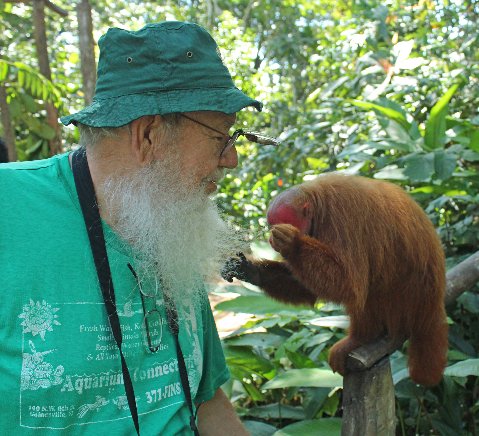Patti and I stood in front of the beautifully planted terrarium at the National Aquarium in Baltimore talking with Jack Cover. Jack, the General Curator, seemed justifiably proud of the success being had with the beautiful taxon we were watching: the Panamanian Golden Frog,
Atelopus zeteki.

We watched as the frogs, yellow or yellow with black spots, moved slowly about their terrarium. Although they sometimes moved in short hops, more often they progressed in a deliberate hand-over-hand manner. Hand waving, a form of silent communication, was frequently used by the frogs.
Learning that this frog was almost extirpated in the wild (since 2007, no wild examples have been found) lent sadness to the beauty and enjoyment we were experiencing at the aquarium.
I first met the Panamanian golden frog,
Atelopus zeteki, back in the 1960s when it was still a subspecies of
A. varius and known as
A. varius zeteki. At that time it was inexpensively, but only occasionally, available in the North American pet trade.
Through the years, the golden frog withstood not only the ravages of over-collecting, but of deforestation that resulted in habitat losses and increasing pollution of the streams along which it lived. But this frog, like many others, was not able to withstand the onslaught of chytridiomycosis, the now famous amphibian fungus disease that rose from virtual obscurity to formidable prominence in the 1990s. As researchers are wont to say, the disease (specifically
Batrachochytrium dendrobatidis) knew no boundaries, affecting and killing frog populations both in and out of protected areas.
But back to the aquarium now: We were encouraged to further learn that there are more than 4 dozen participating facilities in the recovery program for this endangered anuran. Still lacking, however, is a program to reintroduce this taxon safely to the wild; to the wild where the pathogen,
Batrachochytrium dendrobatidis, is still lurking.
More photos below...
A trio of Panamanian Golden Frogs in their lushly planted terrarium.

Hand waving (as the frog on the right is doing) is a method of communication for this species.

 Author, photographer, and columnist Richard Bartlett is one of the most prolific writers on herpetological subjects in the 20th century. With hundreds of books and articles to their credit, Richard and his wife Pat have spent over four decades documenting reptiles both in the field and in captivity. For a list of their current titles, please visit their page in our bookstore. Author, photographer, and columnist Richard Bartlett is one of the most prolific writers on herpetological subjects in the 20th century. With hundreds of books and articles to their credit, Richard and his wife Pat have spent over four decades documenting reptiles both in the field and in captivity. For a list of their current titles, please visit their page in our bookstore. |




To prevent automated Bots from commentspamming, please enter the string you see in the image below in the appropriate input box. Your comment will only be submitted if the strings match. Please ensure that your browser supports and accepts cookies, or your comment cannot be verified correctly.